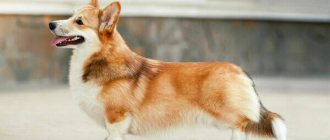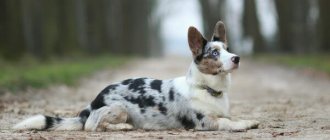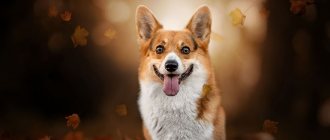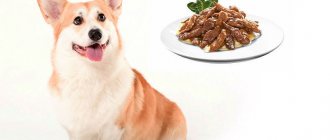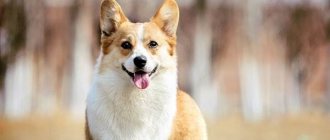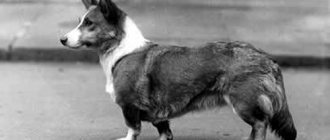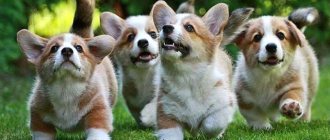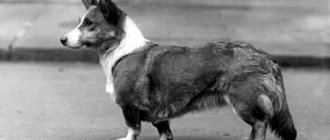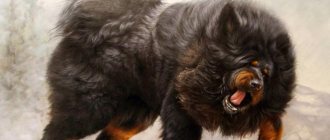| Breed name: | Welsh Corgi Pembroke |
| Breed name in English: | Welsh corgi rembroke |
| Country of origin: | UK (Wales) |
| Type: | A small dog |
| Weight: | 9-12 kilograms |
| Height (height at withers): | 25-30 centimeters |
| Color | White, red, sable |
| Wool length | Short |
| Lifespan: | 12-15 years |
| Character | Smart, loyal, active |
| Number of puppies (average): | 3-8 |
| Price of puppies: | From 1000$ |
Description
The Pembroke Welsh Corgi is a small dog of short stature and strong build. The animal is a wonderful companion. It is very sweet, smart, active and loyal. This breed and the Cardigan Welsh Corgi are often confused, despite their clear differences. Pembrokes have a slightly smaller body, pointed ears and short tails. But the cardigan, on the contrary, has a long tail.
Appearance of a Welsh Corgi
In 1934, two separate breed standards were approved - the Pembroke Welsh Corgi and the Cardigan Welsh Corgi . These breeds have some differences in appearance.
| Main differences between breeds | |
| Welsh Corgi Pembroke | Welsh Corgi Cardigan |
| Neck length | |
| Quite long | Regular length |
| Tail length | |
| Various lengths (including bob tail) | Always long |
| Paw length | |
| Short | Short, but slightly longer than the Pembroke, so the cardigan grows longer |
| Coat color | |
| Shades of red and brown (even black) with white, defined by the standard, are tricolor. They have a characteristic mouth shape (“smile”) | In addition to the colors, the Pembroke has additional colors, it can be brindle or have a blue merle color. There are black masks around the nose and eyes |
| Eye color | |
| Only dark (brown) | In addition to dark brown, one or both eyes can be blue or blue (with blue merle coat color) |
Features of the appearance of the Pembroke Welsh Corgi
The Pembroke Welsh Corgi has a well-defined mouth that gives the impression that they are smiling.
Pembroke Welsh Corgi. Photo: luckyno3 Previously, Pembrokes had to have their tails docked if they were born with longer tails than expected. However, now that many countries have banned cosmetic surgery on animals, you can often find Pembrokes with tails of varying lengths.
FCI Welsh Corgi breed standard
The main characteristics of the breed according to the FCI standard (Fédération Cynologique Internationale - International Cynological Federation):
- The Pembroke Welsh Corgi has a fox-shaped head and a black nose. The eyes are well set, round, of medium size; Eye color is brown or darker than coat color. The ears are erect, slightly rounded, and medium in size. A conventional straight line should pass through the tip of the nose, the center of the eye and the tip of the ear.
- The neck is quite long.
- The body is moderately long. The topline is level. The forelimbs are short and fairly straight, the elbows are pressed to the body. The hind limbs are short and strong. The paws are oval, the two toes in the center of the paw are slightly longer than the others.
- The tail is short, preferably natural. If docked, it is short. If not docked, it should be set on the topline and carried above it when moving or alert.
- The coat is medium length, straight with a dense undercoat, never soft, wavy or harsh.
- Colour: Solid red, sable, fawn, black and tan, with or without white markings on legs, chest and neck. Small white markings are acceptable on the head and muzzle.
- Height: 25-30 cm.
- Weight: 9-12 kg.
The famous short tail is characteristic of the Pembroke Welsh Corgi. Photo: Daniel Stockman
Features of the appearance of the Welsh Corgi Cardigan
The Cardigan Welsh Corgi always has a long tail, and its paws are slightly longer than those of the Pembroke, making the Cardigan slightly taller.
Welsh Corgi Cardigan. Photo: Stijn Bokhove In addition, the cardigan has a wider choice of wool colors.
FCI Welsh Corgi Cardigan Standard
Basic requirements for the breed according to FCI:
- The head is fox-shaped, the nose is black. The eyes are medium in size, set fairly wide apart, the preferred eye color is dark or close to the coat color. Light blue, blue or blue-spotted color of one or both eyes is acceptable if the coat is blue merle.
- The ears are erect, strong, and quite large. The tips are rounded. A conditional straight line should pass through the tip of the nose, the center of the eye and the tip of the ear.
- The neck is muscular, well developed, proportional to the body.
- The body is quite long and strong. The forelimbs are short, wide, free in movement, the elbows are adjacent to the sides. The hind legs are muscular, with well-developed hips and hocks. Paws: rounded, large.
- The tail resembles a fox's. Moderately long, almost touching the ground. The resting position is low, when moving below the line of the back or slightly above.
- Coat: short to medium length. The hair is straight, hard with a thick undercoat.
- Color: red, sable, brindle, tri-color with various markings, blue merle are allowed. There are black masks around the eyes and nose. White may be present on the paws, face, neck, chest, lower body and tip of the tail.
- Height: 30 cm.
- Weight is proportional to body size.
Cardigan Welsh Corgi, blue merle color. Photo: Ida Brauner
Appearance
— Advertising —
The dog has a strong build, smooth fur and an intelligent facial expression.
An adult Pembroke Welsh Corgi weighs about 9-12 kilograms and is 25-30 centimeters tall.
The head of the individuals is similar to that of a fox. The skull is wide and has a small “cavity” at eye level. The muzzle is conical, the nose is black. The eyes are well set and brown in color. Corgi ears stand straight up. They are long, rounded at the end, and medium in size.
— Advertising —
The neck is quite elongated. The pet's front legs are short and straight, slightly curved. Body of medium length. The hind legs are slightly rounded and powerful.
This breed may or may not have tails. They come in these forms:
- Spiral twisted like a corkscrew.
- Throwed over the back, like a fox.
- In the form of a lowered saber.
Many owners prefer to have their ponytails docked.
The dog's coat is dense and of medium length. There are several possible colors: various shades of red with white spots on the feet, neck and chest; sable coloring (black hairs alternate with red); a color called tricolor (for example, black and red with white spots).
Breed standard Welsh Corgi Pembroke FCI-Standard No.39 / 28.11.2003 / GB
General form
A squat, strong dog, compact and active, looks strong and resilient. Figure No. 1. Shouldn't be too low or rude. Figure No. 2,3.
As a representative of the herding group, the dog must be in good physical shape, able to complete the assigned task with enthusiasm and vigor, be energetic and active.
The Pembroke is an energetic, sensible little dog whose kind and lively expression demonstrates intelligence and a sense of humor, which is one of the breed's most attractive traits. Being timid or angry is completely uncharacteristic of the Pembroke.
This is a squat, moderately elongated dog. The distance from the withers to the base of the tail should be approximately 40% greater than the distance from the withers to the ground.
Height at withers: 25 – 30 cm.
Weight is proportional to height, but not more than 13.6 kg for males and 12.7 kg for females.
Weight in show condition: males - about 12.3 kg, females - about 11.4 kg.
Head and forehead
The head is reminiscent of a fox in shape and appearance, but without its inherent cunning expression.
The nose is black, well pigmented. Figure 6.
Mouth
The bite is scissor, with the inside of the upper incisors touching the outside of the lower incisors.
A tight (straight) bite is allowed. Undershot or overshot are considered serious deficiencies. Lips are black, tight-fitting, dry.
Neck
The neck is long enough to ensure the dog's normal balance. Slightly curved, dry, with a smooth transition to the shoulders. Picture 1.
A very short neck or an excessively long, thin or sheep-like neck are faults.
Body (body)
The chest (ribs) should be voluminous, slightly ovoid in shape and moderately long. The chest is deep and sinks strongly between the front legs. The egg-shaped (oval) shape of the chest provides freedom of movement for the dog. The structure of the chest determines most of the length of the corgi's body; the correct rib cage supports the back and helps the body have the correct lower back for the corgi. The lower back is the only place in the body of the back that is not supported in any way by a bone structure. A short, strong loin is necessary so that the Corgi can turn easily, changing direction instantly.
Tail
Previously, the corgi's tail was docked as short as possible. Now tails are rarely docked.
Sometimes puppies are born straight up with bobtails. Sometimes in the same litter both bobtail puppies (without a tail) and puppies with a tail are born.
Color
All dogs presented in Figures 12-15 correspond to standard colors (see standard): sable and white, black-headed tricolor, red and white male and female.
Front legs
The forelimbs are short, the forearms are slightly turned inward, the distance between the wrists is less than between the shoulder joints. Figure 19.
The shoulder blades are long, well laid back along the chest. The length of the shoulder is almost equal to the length of the shoulder blade. The shoulder muscles should be long, smooth and even. The blade is located at an angle of approximately 45 degrees to the horizontal.
A straight shoulder blade or a short shoulder are faults and cause a shortened hopping stride. Figure 20 and 21.
Paws
Oval, with two central fingers slightly protruding from the two outer ones. It turns neither in nor out. The pads are strong, the paw is curved. The claws are short. Strong arched paws are essential as they support the body weight on the small paw area.
Posterior
Broad bones, strong and agile, with moderate angulation at the knees and hocks. All joints in the hindquarters must be in balance with the joints in the forequarters for the dog to function and move properly. If the angles of one joint are not aligned with the angles of another, an imbalance occurs. The posterior section is responsible for forward movement. The corgi's hip angles should correspond to the scapulohumeral angle and be approximately 90 degrees.
A too sharp hip angle creates a saber-shaped (sickle-shaped) stance of the hind legs (the lower part of the hind leg goes far under the dog’s body). In this case, the dog appears to be crouching even when standing. This flaw also interferes with proper movements. If the angle is incorrect, the dog moves in short mincing steps and the topline may rise.
The thigh should be muscular. Good development of the thigh muscles is necessary for freedom of movement and is achieved through exercise.
Pros and cons of a dog
Characteristics of advantages:
- This is a playful, active, athletic dog that will always enjoy exercise.
- Loving and faithful.
- Has short coat, easy to care for.
- The dog is polite with strangers, but at the same time is a good watchman.
- The pet gets along well with other pets.
- This is a relatively healthy breed that rarely suffers from hereditary diseases.
Characteristics of minuses:
- In the absence of mental and physical stress, pets will chew and destroy objects in the house.
- The dog has territorial aggression towards animals he does not know.
- The dog sheds heavily in the fall and spring.
- One of the bad habits of some individuals is to constantly bark.
- Animals love to chase everything that moves.
- This is an expensive breed, especially if the puppies are elite.
Lifespan of a Welsh Corgi
Welsh Corgi dogs are long-lived and can live 12-15 years with good care and sufficient exercise. But there are factors that can shorten the life of these wonderful dogs.
Factors influencing the lifespan of a Welsh Corgi:
- Obesity
One of the factors that greatly shortens the life of a Welsh Corgi. Dogs of this breed are very prone to obesity and it is necessary to monitor their diet very carefully. Provide them with nutritious food that is low in fat. And also do not give food from the table and monitor your pet’s weight. Obese Welsh Corgis live 2-5 years less than healthy Corgis. Their life expectancy is reduced due to the heavy load on the heart.
- Difficult birth
Also a factor that shortens the life of a corgi. Every second dog has to undergo a caesarean section. Some dogs die in childbirth if help is not provided in time. Therefore, to preserve and increase life expectancy , corgis should be bred by professionals.
- Long spine
It is an aggravating factor in the breed throughout the life of the corgi. The Welsh Corgi has an elongated spine and this can provoke pinched intervertebral discs, especially the cervical ones. Therefore, you should monitor the physical exercises your dog does. You should be careful when jumping so as not to damage the spine and paws.
- Eye diseases
Corgi life expectancy by eye diseases, which can shorten the dog's life. Make her lethargic and passive. Therefore, it is very important to visit a veterinarian on time so as not to miss the dangerous development of the disease.
It is impossible to give a definite answer to the question how long do corgis live A lot depends on the genetics, care and maintenance of the Welsh Corgi. In general, this is a healthy breed and, if cared for, will live to a ripe old age. If corgis live a full, active and vibrant life, then they will delight their owners with their cute faces for a very long time. This is a strong, active dog that can win the heart of every person. It contains the intelligence and courage of a shepherd and the funny appearance of a fox. And the lifespan of this amazing breed largely depends on the attention of the owner and understanding of the problems of the breed.
History of the breed
There is a legend that Pembroke Corgis were the horses of Welsh fairies. This is evidenced by the coloring on their back in the shape of a saddle.
The Pembroke Welsh Corgi was first mentioned in records in 920 AD. They are believed to have been brought to Wales by Flemish weavers. From the 14th to the 18th centuries they were used only for grazing livestock. Thanks to their small stature and agility, the dogs bit cattle on the legs and then managed to dodge the blows.
As the name suggests, the Pembroke Welsh Corgi was bred in Wales in the Pembrokeshire region. The Cardigan Welsh Corgi is the older of the two Corgi breeds. Therefore, of course, it was used in breeding the Pembroke species.
The breed was recognized by the English Kennel Club in 1928. Back then, Pembroke and cardigan were considered the same species. Only in 1934 a standard for each type was identified.
The Pembroke's appeal increased when it became a favorite of King George VI and subsequently Queen Elizabeth II. By the 1960s, the Corgi had become one of the most popular pet breeds throughout the world, especially in Britain.
Maintenance and care
The Pembroke Welsh Corgi has a medium length coat with a short undercoat. The breed has a tendency to lose a significant amount of it. This occurs especially intensively in spring and autumn. Regular grooming of your dog is very important. It mainly consists of brushing the coat once or twice a week. During molting, carry out the procedure daily. Brushing should ideally take 10 minutes to completely remove dead hair.
The frequency of bathing will vary depending on what activities your dog participates in. It is recommended to bathe your dog every 6-8 weeks. For the procedure, use warm water and special shampoo.
Groom and trim your pet's nails regularly to prevent furniture scratching. It is recommended to carry out the procedure every 2-3 weeks.
Keep your pet's teeth and gums healthy. To do this, clean them daily or at least a couple of times a week.
This is an active breed that loves to run. Therefore, it is important to give your pet daily exercise to prevent obesity. Too much wasted energy and lack of training can lead to excessive barking and other behavior problems.
Conditions of detention
Caring for puppies
At the age of six months, puppies love to chew on wires and shoes; you need to carefully hide all valuables so that the dog does not spoil them. Buy your pet as many toys as possible to keep him occupied and not sharpening his teeth on furniture.
puppies need a lot of toys so they don't get bored
Walks
Puppies are walked 5-6 times a day, adults especially 2-3 times. The more often you take your animal for a walk and play with him, the more his immunity will strengthen. A dog needs physical activity, without it it languishes.
Grooming
Pembrokes are clean. Their fur is not very long and thick, so it only needs to be brushed once a week. During shedding, you should use a furminator. Due to their short stature, pets often get their tummy dirty when walking. Dirt is removed using a sponge soaked in water. Animals should be bathed no more than 2 times a year.
Feeding
The pet should not be overfed. Corgis love to eat, do not leave a bag of food or food on the table in their sight, the dog will eat everything as soon as you lose your vigilance. Puppies eat 5 times a day, adults 2 times. It is preferable to feed premium-class dry food in accordance with the instructions on the package. The Pembroke Welsh Corgi's natural menu includes beef, cottage cheese, eggs, vegetables, cereals, vitamins and minerals.
an adult dog is fed twice a day with dry elite food
Nutrition
Feed adult dogs a high-quality food. Follow these guidelines, but take into account the general activity of the animal:
- Weighing 9 kg or more – from 129 to 176 g.
- Weighing 10 kg or more – from 139 to 189 g.
- Weighing 11 kg or more – from 149 to 196 g.
- Weighing 12 kg or more – from 159 to 209 g.
Feed twice a day: the first time in the morning and the second in the evening. Do not overfeed your pet, no matter how much he asks. Excessive amounts of food lead to obesity and shortened lifespan of individuals.
Older Corgis should be fed food that suits their needs at this stage of life. It is important to choose the right food. Below is the approximate amount of necessary substances for an elderly dog:
- Protein from 14 to 21%.
- Fats less than 10%.
- Fiber less than 4%.
- Calcium 0.5-0.8%.
- Phosphorus 0.4-0.7%.
- Sodium 0.2-0.4%.
WELSH CORGI PEMBROKE
FCI STANDARD 39
Country of origin: Great Britain GENERAL IMPRESSION: squat, powerful, strong, alert and lively dog, with small dimensions it gives the impression of solidity and strength. CHARACTERISTICS: brave and dexterous. TEMPERAMENT: Reasonable and friendly, not nervous or aggressive. HEAD and SKULL: The head is fox-like in shape and impression, with a lively, intelligent expression. The skull between the ears is quite wide and flat, with a moderately pronounced transition from the forehead to the muzzle. The length of the muzzle is related to the length of the skull as 3:5. The muzzle ends with a slight point. The nose is black. MUZZLE / BITE: powerful jaws with an excellent, even and full-toothed scissor bite, with the upper row of incisors set without gap in front of the lower one, the teeth stand vertically in the jaw. EYES: well set, round, medium size, brown, matching the color tone. EARS: erect, medium size, slightly rounded. The imaginary straight line from the nose through the eye should pass in its continuation through the top of the ear or very close. NECK: Proportionately long. FOREQUARTERS: Short and as straight as possible. The shoulders fit tightly to the arch of the chest. The bones are massive right down to the paws. The elbows fit tightly to the sides of the body, while not loose, but not too tight. The shoulder blades are well positioned and form a 90 degree angle with the humerus bones. BODY: medium length, well arched ribs, loin not short, slightly tapering when viewed from above. Straight back. The chest is wide and deep, well let down between the forelegs. HINDQUARTERS: Powerful and flexible, well-defined stifle angles. The metatarsus are steep, with massive bones. The hock joints are straight when viewed from behind. FEET: Oval, powerful, well-closed, tightly knit toes, both middle toes standing slightly in front of the two outer toes. The pads are thick and dense. The claws are short. TAIL: short natural. Docked: short. Undocked: kept level with the topline, carried above the topline when moving. MOVEMENTS: free and active, not loose, but not tied up either. The forelimbs are well carried forward, but do not rise very high in accordance with the push of the hind limbs. COAT: Medium length, straight, with a dense undercoat, never soft, wavy or wiry. COLOR: solid red, sable, fawn, black and tan, with or without white markings on the legs, chest and neck. Small white markings on the head and muzzle are acceptable. HEIGHT / WEIGHT: height at withers approximately 25.4 to 30.5 cm. Weight: males 10-12 kg, females 10-11 kg. DISADVANTAGES: Any deviation from the above points must be considered as a defect, the assessment of which must be in exact proportion to the degree of this deviation. NOTE: Males must have two obvious, normally developed testes, which must be completely contained in the scrotum.
FCI STANDARD 38
Country of origin: Great Britain GENERAL IMPRESSION: stable, strong, agile, hardy dog. Long in proportion to height. The tail looks like a fox's tail. Set in line with the body. CHARACTERISTICS: alert, active and intelligent dog. TEMPERAMENT: alert, intelligent, balanced, not timid, but not aggressive either. HEAD and SKULL: The head is similar in shape and expression to that of a fox. The skull between the ears is wide and flat, tapering towards the eyes, over which it is slightly convex. Moderate transition from forehead to muzzle. The length of the muzzle is related to the length of the skull as 3:5. The muzzle gradually tapers towards the nose, which projects slightly and is in no way blunt. The lower jaw is symmetrical, clearly defined, but not excessively prominent. The nose is black. MUZZLE/BITE: strong teeth, scissor bite, with the upper incisors set in front of the lower ones without gap, the teeth stand vertically in the jaw. EYES: medium in size, clear, with a friendly, lively but alert expression, set quite far apart with clearly defined corners of the eyes. Mostly dark or in a color that harmonizes with the coat color. Eyelids are dark. Pale blue, blue and merle eyes (one or both) are allowed exclusively in the blue merle color. EARS: erect, relatively large in relation to the height of the dog. Slightly rounded at the top, moderately wide at the base and spaced about 9 cm apart. They are carried so that the apexes are slightly outside an imaginary line from the nose through the middle of the eyes. NECK: muscular, well developed in relation to the dog’s body and with a harmonious transition into obliquely set shoulders. FOREQUARTERS: Shoulder blades well sloping and forming an angle of approximately 90 degrees with the shoulders, muscular. The elbows fit tightly to the sides of the chest. The bones are massive right down to the paws. The limbs are short, however, the body still has a good lift off the ground. The forearms are slightly curved to match the arch of the ribcage. The paws are slightly turned outward. BODY: The chest is moderately wide with a pronounced chest bone. The body is quite long and powerful with a deep chest, well sprung ribs and a clearly defined waist. The back is straight. HINDQUARTERS: Strong, well angulated and set, with muscular thighs and shins. The limbs are short with strong bones. When viewed from the side and behind, the hocks are set vertically when standing. FEET: Round, closed, fairly large with well padded pads. Dewclaws should be removed. TAIL: similar to that of a fox, set in line with the body, relatively long (touching or almost touching the ground). When standing it is kept low; when moving it can be carried easily elevated above the body, but not rolled over the back. MOVEMENTS: free and active. The elbows fit snugly to the sides of the body, but are not loose, but not too tight either. The forelegs are thrown forward well, but without excessive lifting, in balance with the drive of the hindquarters. COAT: short or medium length, hard texture, resistant to any weather, with good undercoat. Mostly straight. COLOR: Any with or without white markings, but white should not predominate. HEIGHT / WEIGHT: Ideal height at the withers is 30 cm. Weight is proportional to height, with a proportional overall appearance being of paramount importance. FAULTS: Any deviation from the above points must be considered as a defect, the assessment of which is in exact proportion to the degree of this deviation. NOTE: Male dogs must have two obvious, normally developed testes, which must be completely contained in the scrotum.
Breeding
Before mating, the health of the individuals is checked. This is especially true for genetic diseases. It is not permissible to breed long-haired, nervous and biting dogs.
Dogs are bred when males are 24 months old and females are 20 months old. Although the first heat in girls occurs at 7-8 months. Females over the age of nine years are not allowed to become pregnant.
The girl is prepared for mating in advance: vaccinations are given, prophylaxis against parasites, the condition of the heart, joints, and thyroid gland is checked.
Before the procedure, the individuals are introduced: they are walked together or left in a room for communication.
The bitch's pregnancy lasts from 2 to 2.5 months. As a result, from 3 to 8 puppies are born. Be sure to ensure that a specialist is present at the birth. Your pet may need a caesarean section.
Puppies
Within the first few days after purchase, take your new friend to the veterinarian. This is necessary to ensure the health of the animal. Visit a specialist periodically for vaccinations, deworming and annual tests.
Pembroke Welsh Corgis need daily exercise to stay in shape. The baby will need more of them than adults. Spend at least 15 minutes a day exercising. Training and education should be carried out by you from a very early age.
Many owners wonder: what is the best way to feed small corgis? Feed your babies special high-quality food. The approximate amount of food depends on body size and age. The scheme is as follows:
- 2 months – from 153 to 161 g.
- 3 months – from 179 to 193 g.
- 4 months – from 191 to 209 g.
- 5 months – from 194 to 213 g.
- 6 months – from 194 to 213 g.
- 8 months – from 157 to 191 g.
- 10 months – from 139 to 147 g.
After your baby reaches 1 year of age, feed him as an adult.
Stick to the following schedule:
- For puppies between 8 and 12 weeks of age, feed food 4 times a day.
- From 3 to 6 months – three times a day.
- From 6 months to 1 year – 2 times a day. Then you can leave eating 2 times a day, or you can reduce it to once.
Photos of the babies are presented below.
Minuses
[adds]
- They bite your heels . Initially, corgis helped shepherds - and, chasing sheep, gathering them into a herd, they bit their paws. This habit is laid down at the genetic level: they still bite people on the heels, trying to gather them into one pile. The teeth themselves do not touch the legs - it is more like an unpleasant pinch. This is especially true among young puppies that have not yet been trained - but the dog can be weaned from this habit if desired.
- Very active . The shepherd's past also makes itself felt in the energy that can accumulate in these small dogs - there can be a lot of it, and if it is not splashed out in time, it can lead to some kind of trouble. If you don't walk your dog three times a day, it may start destroying the furniture in your apartment - so if you don't have time for this, it's better not to even think about buying a corgi puppy.
- Very gluttonous . Corgis are quite large in themselves, so if you start feeding them as if for slaughter, they can easily become obese. There are comorbidities associated with obesity, so you need to choose your dog’s diet very carefully.
- They require careful grooming . The thick coat of a corgi is not only their advantage, but also a disadvantage, especially for a lazy owner. The dog needs to be brushed regularly so that the coat does not get tangled, and even more so when it starts to shed.
- They don't know how to protect the territory . There are fighting dogs, there are those who are so devoted to their owners that they threaten to attack only when they hear danger - and there are corgis who love everyone, indiscriminately. It is not recommended to leave this breed to guard the house, since excessive affection will not only not scare away the burglar, but will also put the corgi himself in danger.
- Fearless . Surprisingly, their absolute capacity for watchdog activity calmly coexists with an insane fearlessness when it comes to communicating with other dogs - especially those that are several times larger than corgis in size. Seeing a dog, even if it is not aggressive, a corgi can rush at it and bark - therefore, it is not recommended to let it off the leash.
- Shrill voice . If a corgi starts barking, no one will think that it is the voice of such a small dog. This may seem like an advantage to some, but if you prefer silence, and loud barking makes your ears ring, you can try to wean your dog off this habit - or not get a corgi at all.
- High price . Since corgis are purebred dogs, it is very difficult to find a representative of the breed even in a shelter. High popularity forces breeders to raise prices for unborn puppies - the price for such joy can rise to 60,000 rubles. Of course, this doesn't stop everyone, but if you're on a tight budget, it might be better to look for a cheaper breed.
Dog character
The pet loves to be close to people. This breed is known to want constant interaction with the entire family. They may suffer from separation anxiety when left alone for long periods of time.
As a companion, the Corgi is protective of its family and will warn of any strangers. Animals need to be socialized at an early age to know how to behave around people they don't know.
Dogs are suitable for children and the elderly. When Corgis become agitated, they may bite their heels in response to play. This is due to their original job of being shepherds.
Pets are known to bark a lot if they are not trained. However, they are easy to train due to their high intelligence. The dog loves to be constantly busy. During training and training, use gentle methods, as the dog does not tolerate roughness.
The dogs get along well with other dogs and pets.
Some Pembrokes love to swim, especially in hot weather. However, if your pet doesn't want to go into the water, never force him. This can frighten the dog and cause him stress.
Education
Pembroke Welsh Corgis are intelligent animals, so training them is not that difficult. Here are some tips you can follow when training:
- Be persistent when training your dog. Like other breeds, Corgis instinctively seek out an "alpha male" or "pack leader." Therefore, you need to show your authority so that the puppy always obeys you.
- Use incentives. Never use harsh methods or force. This attitude will make your puppy fear you rather than respect you. Instead of yelling or intimidating your dog, give him treats for doing the right thing. However, don't overdo it with rewards. Overfeeding individuals leads to obesity.
- Socialize your puppy from an early age. Don't be afraid to introduce him to new situations, people and other animals.
- Be consistent. For example, don't reward your dog both times he gets a trick right and only gets it halfway the second time. This will send mixed signals to your pet. He will not understand what actions are correct.
- The first commands your pet should know are: come, sit, stay, be quiet, no, leave it, place.
Dog care
A balanced diet, physical and mental exercise is an ideal life for herding dogs. Corgis are one of these; representatives of the breed are still used as shepherds for flocks. This means that the dogs are extremely hardy and agile, despite their dwarf size.
On a note! Although it is difficult to call a corgi, whose weight is 9-12 kg, a dwarf, representatives of the breed are far from gigantic. But, like their larger relatives, “cakes” need proper care.
Content
If a crusty dog is kept in an apartment, he needs a bed. You shouldn’t buy one that’s too big; choose a bed so that the dog can stretch out on it to its full height.
Basic items your pet needs:
- Bed.
- Bowl for food and water. It is better to take bowls on a stand that can be adjusted to suit the dog’s height.
- Toys. Corgi owners tend to buy a large number of toys, but in fact, two small, identical balls on a string and a puller are enough for the animal.
- Comb for dogs.
- Scissors for trimming nails.
- Leash, collar, address tag.
- Zoo shampoo for dogs.
This may include disposable puppy diapers, a paw wash, and a robe for dogs to put on for drying after a bath.
Care and hygiene
Welsh Corgis with short hair do not require extensive grooming. They are brushed twice a week and their paws are washed after each walk. As for a complete wash, it is carried out if the dog is very dirty. There is no need to wash the animal regularly, since this removes the protective fatty film from the coat.
It is recommended to wash your corgi in the bathroom only if it is heavily soiled.
Long-haired Corchs are brushed three to four times a week. Some people resort to the services of a groomer to maintain their pet’s beautiful coat.
Ears, eyes and teeth are examined every day. Contaminants are carefully removed from the eyes with a damp cotton swab. The ears are cleaned twice a month, using special wipes for dogs for this purpose.
Important! Corgi teeth are cleaned with dog toothpaste. Tartar can be removed using apples. In this regard, the “korzhas” are given unsweetened varieties of apples once a week.
Natural nutrition
An adult representative of the Pembroke Corgi dog breed is fed twice a day, babies - from 5 to 3 times, depending on age.
An approximate list of allowed foods for corgis:
- Meat: turkey, rabbit, beef, horse meat. Chicken - with caution, as it can cause allergies.
- By-products (except kidneys).
- Cereals: rice, buckwheat, millet (rarely).
- Dairy products: low-fat kefir and cottage cheese.
- Chicken and quail eggs.
- Vegetables, with the exception of beets and potatoes.
- Fruits (except grapes, citrus fruits).
- Dry biscuits as a treat.
The proportions of the daily norm are:
- Meat, including offal – 50%.
- Vegetables – 30%.
- Cereals – 15%.
- Fats – 5%.
Important! Fats, both plant and animal origin, are given very carefully, observing the reaction of the dog’s body.
Sometimes a corgi can be pampered with watermelon, but only in small quantities.
Walking and physical activity
Corgi are active dogs that can walk several tens of kilometers a day. Of course, a modern person does not have time for such trips, but daily walks of 3-4 hours are mandatory for a dog.
In the mornings, the pet is walked for 1–1.5 hours, the rest is “groomed” in the evening if the pet is accustomed to being walked twice a day, or divided into more times.
Walking with a “korzhik” is not just walking on a leash according to the principle “the owner is on his own, and the dog is on his own.” Walking means playing puller or ball, making a short-legged dog run after them. Physical activity alternates with mental activity, in other words, commands are practiced with the dog for 15-20 minutes, and then they are allowed to relax in the game.
Diseases
The Pembroke Welsh Corgi is considered a healthy dog. But there are a number of diseases and health conditions that are genetic. This does not mean that your pet will necessarily have such problems. It just needs to be noted that the species is at greater risk of contracting the disease than other breeds. Here is a description of some common genetic problems:
- Heart diseases. Pembrokes are susceptible to a condition called incomplete closure of the heart valve. In this condition, the small valve that passes blood between the two parts of the heart does not close properly. Therefore, too much blood enters the lungs, which leads to fluid accumulation and increased stress on the heart. Main signs: cough, fatigue during exercise, weight loss, shortness of breath and weakness in the hind legs. Contact a specialist immediately.
- Blood clotting disorder. The animal appears healthy until serious injury or surgery occurs. As a result, severe bleeding may occur. Von Willebrand's disease is a bleeding disorder that is common in Pembroke Corgis.
- Problems with the spine. Intervertebral disc disease is a common condition in dogs with long backs and short legs. It occurs when the jelly-like cushion between one or more vertebrae slips or ruptures. This causes the disc to press on the spinal cord. Symptoms of the disease: the dog moves poorly, refuses to climb stairs, has a hunched back, and cries. All this is caused by pain. Contact your veterinarian immediately.
- Dysplasia of the hip and elbow joints. Your pet's hips and elbows are at risk for dysplasia. This is an inherited disease that causes abnormal joint development and leads to arthritis. Stiffness in your Pembroke's elbows or hips can be a problem for him. Symptoms: lameness in the legs, the dog has difficulty standing up. The sooner you treat your pet, the better it will be for his health.
- Eye problems:
- cataract
- progressive retinal atrophy
- persistent pupillary membrane. This occurs when small pieces of tissue that should disappear soon after birth remain attached to the iris.
In addition to hereditary diseases, the animal may be susceptible to common diseases:
- Dental problems.
- Obesity.
- Parasites.
- Infections.
Pembroke Welsh Corgi breed standard
FCI 39 (04.11.2010)Country of Origin: UK
PURPOSE:
shepherd dog.
FCI CLASSIFICATION:
Group 1. Guard and racing dogs (except for Swiss Cattle Dogs) Section 1. Shepherd dogs without working tests
GENERAL FORM:
The dog is short, strong, well-built, lively and active, and despite its small size it gives the impression of great strength in both body and spirit.
CHARACTERISTIC:
the determined look of a working dog.
BEHAVIOR:
open, friendly, without a trace of aggression or nervousness.
HEAD and SKULL:
the head in shape and appearance resembles a fox, the expression is lively, intelligent; the skull between the ears is very wide and flat; the transition from the forehead to the muzzle is moderately pronounced. The length of the muzzle in proportion to the skull is 3 to 5. The muzzle tapers slightly. The nose is black.
TEETH:
The jaws are strong, with an ideal regular scissor bite, i.e., the upper teeth overlap the lower teeth and are set vertically in the jaws.
EYES:
well set, round, medium size, brown, harmoniously combined with coat color.
EARS:
erect, medium size, slightly rounded. A line drawn from the tip of the nose to the eye should, when continued, pass through the tip of the ear or close to it.
NECK:
very long.
FRAME:
medium length, with convex, rounded ribs, not short-jointed, slightly tapering when viewed from above. Smooth topline. The chest is wide and deep, well let down between the forelegs.
TAIL:
short, preferably short from birth rather than docked. Docked: short. Undocked: Set on in line with the topline. The dog wears its tail low, without curling it over its back. When moving, it rises to the line of the back; when at rest, it is lowered low. Carrying the tail too high or too low is undesirable.
FORE LIMBS:
the forearms are short and as straight as possible, the upper part is shaped in such a way that it seems to cover the chest. The bone is wide all the way to the paw. Elbows are close to the sides, neither loose nor stiff. The shoulder blades are well set and form an angle of 90 degrees with the forearm.
HINDQUARTERS:
strong and flexible, with good knee joint angles. Legs are short. The bone is wide all the way to the paw. The metatarsals are straight when viewed from behind.
PAWS:
oval, fingers strong, arched, tightly closed, two middle fingers slightly protruding forward, pads strong and rounded. The claws are short.
MOVEMENTS:
movements are free and active, at the same time neither constrained nor “loose.” The front legs are well carried forward, with a not too high rise, movements in unison with the pushing movements of the hind legs.
COAT:
medium length, straight, with a dense undercoat, in no way soft, not wavy, not hard.
COLOR:
red, sable, fawn, black and tan, with or without white markings on the legs, chest and neck. A little white on the head and muzzle is acceptable.
HEIGHT WEIGHT:
Height: Height at withers approximately 25 - 30 cm (10 - 12 inches). Weight: for males - 10 -12 kg (from 22 to 26 feet); in females - 9 - 11 kg (from 20 to 20 feet).
FLAWS:
Any deviation from the above points should be considered as a defect. The seriousness with which a fault is considered must be in exact proportion to its severity and impact on the dog's health and ability to perform traditional work.
DISQUALIFYING FAULTS:
Aggression or cowardice. Dogs with physical or behavioral abnormalities are subject to disqualification.
NB:
Males must have two normally developed testes, fully descended into the scrotum.
Interesting Facts
- Pembroke's personality was described in one article as being a cross between a sea captain and a high school teacher. He enjoys being involved and in charge at the same time.
- In 2012, Orange Country hosted its first Corgi Beach Day. At first it was an exhibition of 15 corgis and their owners. Today, it has become a series of organized events throughout the country. The world record took place in Huntington, California. Information states that more than 1,200 spectators attended the event.
- A Pembroke named Rufus belonged to the editor-in-chief of Amazon.com. At the stage of site promotion, he came to work with the owner every day, walked around the halls, attended meetings and dozed off during them. Later, Rufus became the site's unofficial mascot.
- For over 70 years, corgis have been part of the British family. Queen Elizabeth was the proud owner of more than 30 corgis. The Pembroke Welsh Corgi is her favorite breed.
- The species has a recessive gene called the fluffy gene. It can be in both a bitch and a dog. If the parents have this gene, then the litter may produce one or more puppies with long hair.
- When the dog lays his body on the ground, from behind his butt looks like two chicken wings. This funny position of the dog is called sploot.
Welsh Corgi
FCI-Standard No.39 / 28.11.2003 / GB Welsh Corgi (Pembroke) Country of origin: Great Britain
Date of publication of the original standard: 10/29/2003 Purpose: herding breed FCI Classification: Group 1 (shepherds and cattle breeds)
Section 1 (shepherds) No shepherd testing.
GENERAL APPEARANCE: stocky, powerful, strong, alert and lively dog, with small dimensions creates the impression of solidity and strength
CHARACTERISTICS: bold and dexterous TEMPERAMENT: reasonable and friendly, not nervous and non-aggressive
HEAD and SKULL: The head is fox-like in shape and impression, with a lively, intelligent expression. The skull between the ears is quite wide and flat, with a moderately pronounced transition from the forehead to the muzzle. The length of the muzzle is related to the length of the skull as 3:5. The muzzle ends with a slight point. The nose is black.
MUZZLE / BITE: powerful jaws with an excellent, even and full-toothed scissor bite, with the upper row of incisors set without gap in front of the lower one, the teeth stand vertically in the jaw.
EYES: well set, round, medium size, brown, matching color tone
EARS: erect, medium size, slightly rounded. The imaginary straight line from the nose through the eye should pass in its continuation through the top of the ear or very close.
NECK: proportionately long BODY: medium length, well arched ribs, loin not short, slightly tapering when viewed from above. Straight back. The chest is wide and deep, well let down between the forelegs.
TAIL: short, preferably natural. Docked: short
Undocked: in line with the body, carried low, not curled over the back. In motion - in line with the line of the back, below - in a calm state. It is undesirable for the tail to be set too low or too high.
FOREQUARTERS: Short and as straight as possible. The shoulders fit tightly to the arch of the chest. The bones are massive right down to the paws. The elbows fit tightly to the sides of the body, while not loose, but not too tight. The shoulder blades are well positioned and form a 90 degree angle with the humerus bones.
HINDQUARTERS: Powerful and flexible, well-defined stifle angles. The metatarsus are steep, with massive bones. Hock joints straight when viewed from behind
FEET: Oval, powerful, well-closed, tightly knit toes, both middle toes standing slightly in front of the two outer toes. The pads are thick and dense. The claws are short.
MOVEMENTS: free and active, not loose, but not tied up either. The forelimbs are well carried forward, but do not rise very high in accordance with the push of the hind limbs.
COAT: Medium length, straight with thick undercoat.
Soft, wavy or excessively hard (like wire) wool is NOT ALLOWED.
COLOR: solid red, sable, fawn, black and tan, with or without white markings on the legs, chest and neck. Small white markings on the head and muzzle are acceptable.
HEIGHT / WEIGHT: height at withers approximately 25.4 to 30.5 cm. Weight: males 10-12 kg, females 10-11 kg.
DISADVANTAGES: Any deviation from the above points must be considered as a defect, the assessment of which must be in exact proportion to the degree of this deviation.
Any dog exhibiting a physical or behavioral abnormality shall be disqualified.
NOTE: Males must have two obvious, normally developed testes, which must be completely contained in the scrotum.
This standard is considered valid from April 2004.
